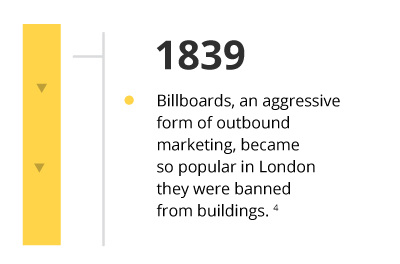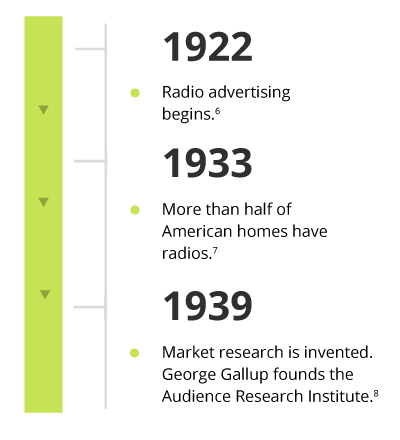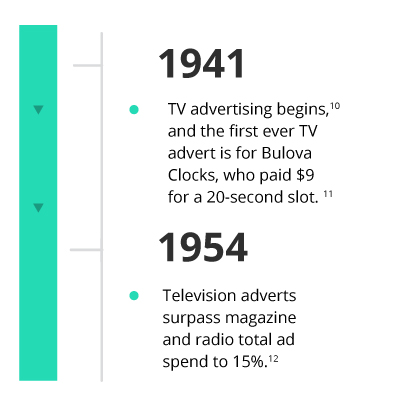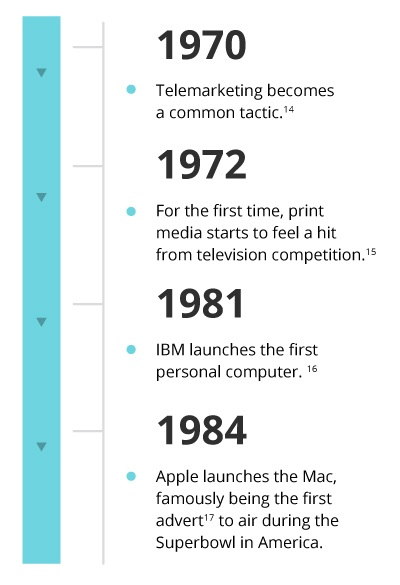The Evolution of Marketing from Trade to Technology


This era was defined by simple, hand created products. A household would produce and consume what they needed, so little marketing was needed. However, what would become major marketing platforms, such as newspaper and magazines, were invented during these early stages.


The Industrial Revolution paved the way for an era defined by low-cost mass production. Advertising during this time was limited as most businesses rightly assumed people would simply want what was available. This style of outbound or interruptive marketing would define how businesses marketed for close to a century before inbound marketing gained momentum in the early 2000s.3


As the market became saturated with mass-produced products, competition began to increase. The marketing tactic during this era relied heavily on sales techniques and undercutting the price of competitors with little concern for quality and customer satisfaction. Together with print media, radio became a popular advertising channel.


During this era, marketing as a business function began to form. All things related to advertising were grouped, forming what we know as the marketing department of a company today.9


Marketing becomes a core focus for companies as they move away from previous methods and start to focus on customer needs for the first time. The “customer is king” saying comes from this era, as businesses survive by meeting customer needs. Pricing strategies advance and distribution channels are defined during this time.13


The “customer is king” marketing tactic continues to refine itself as businesses begin to focus on building lasting relationships with their customers. The goal is to create relationships and loyalty to ensure customers keep coming back.18


In this era, inbound or permission marketing takes off. The relationship between customers and businesses shifts as customers begin to dictate how they receive content as opposed to businesses pushing content. By signing up to a newsletter or following a brand on social media, you invite the content you want into your life.

Where to from here?
From the Marketing Company Era beginning in the 1960s when marketing efforts began to take the customers’ needs into account, the importance of the consumer has grown into the central focus of marketing strategies today. As big data becomes a fundamental marketing tool, businesses may be able to access and analyse large-scale social media and browsing behaviour using artificial intelligence and machine learning.65 With this information, complete customer profiles can be developed, and streamed into narrow segments of preferences, likes, and dislikes. With this level of insight, businesses may be able to make more targeted decisions aimed at those most likely to purchase their product.66 Taking it a step further, using the data collected, businesses will be able to predict consumers needs and create the first consumer-responsive products.67
AI is said to potentially be the biggest change in marketing since the beginning of digital, with “80% of marketing executives predicting AI will revolutionise marketing by 2020.”68
As technology continues to rapidly disrupt industries, it is essential to adapt with it and understand how trends in marketing could affect you or your business. The only way to foresee how great the change will be is to remain as relevant as possible as new trends and technology become available every day.
- 1 Palermo, E. (Feb, 2014). ‘Who invented the printing press?’. Retrieved from LiveScience.
- 2 Lambert, T. (2018). ‘A brief history of newspapers’. Retrieved from: Localhistories.
- 3 Faudree, M. (Oct, 2016). ‘The seven eras of marketing’. Retrieved from Simplexity.
- 4 Wainwright, C. (Feb, 2012). ‘The history of marketing: An exhaustive timeline [infographic]’. Retrieved from HubSpot.
- 5 Faudree, M. (Oct, 2016). ‘The seven eras of marketing’. Retrieved from Simplexity.
- 6 Wainwright, C. (Feb, 2012). ‘The history of marketing: An exhaustive timeline [infographic]’. Retrieved from HubSpot.
- 7 Wainwright, C. (Feb, 2012). ‘The history of marketing: An exhaustive timeline [infographic]’. Retrieved from HubSpot.
- 8 Johnson, B. (Mar, 2010). ‘From the great depression through the great recession: A brief history of marketing’. Retrieved from AdAge.
- 9 Faudree, M. (Oct, 2016). ‘The seven eras of marketing’. Retrieved from
- 10 Wainwright, C. (Feb, 2012). ‘The history of marketing: An exhaustive timeline [infographic]’. Retrieved from
- 11 The Drum. (Mar, 2016). ‘1941: Bulova airs first-ever TV commercial in 1941 before Brooklyn Dodgers game’. Retrieved from The Drum.
- 12 Wainwright, C. (Feb, 2012). ‘The history of marketing: An exhaustive timeline [infographic]’. Retrieved from HubSpot.
- 13 Faudree, M. (Oct, 2016). ‘The seven eras of marketing’. Retrieved from Simplexity.
- 14 Wainwright, C. (Feb, 2012). ‘The history of marketing: An exhaustive timeline [infographic]’. Retrieved from HubSpot.
- 15 Wainwright, C. (Feb, 2012). ‘The history of marketing: An exhaustive timeline [infographic]’. Retrieved from HubSpot.
- 16 Wainwright, C. (Feb, 2012). ‘The history of marketing: An exhaustive timeline [infographic]’. Retrieved from HubSpot.
- 17 Taube, A. (Jan, 2014). ‘How the greatest super bowl ad ever – Apple’s ‘1984’ – almost didn’t make it to air’. Retrieved from Business Insider.
- 18 Faudree, M. (Oct, 2016). ‘The seven eras of marketing’. Retrieved from Simplexity.
- 19 Nayar, V. (Aug, 2017). ‘The history and evolution of digital marketing’. Retrieved from AvivDigital.
- 20 Singel, R. (Oct, 2010). ‘Oct. 27, 1994: Web Gives Birth to Banner Ads’. Retrieved from Wired.
- 21 Oberoi, A. (Jul, 2013). ‘The history of online advertising’. Retrieved from Adpushup.
- 22 Wainwright, C. (Feb, 2012). ‘The history of marketing: An exhaustive timeline [infographic]’. Retrieved from HubSpot
- 23 Wainwright, C. (Feb, 2012). ‘The history of marketing: An exhaustive timeline [infographic]’. Retrieved from HubSpot
- 24 Wainwright, C. (Feb, 2012). ‘The history of marketing: An exhaustive timeline [infographic]’. Retrieved from HubSpot
- 25 Wainwright, C. (Feb, 2012). ‘The history of marketing: An exhaustive timeline [infographic]’. Retrieved from HubSpot
- 26 Wainwright, C. (Feb, 2012). ‘The history of marketing: An exhaustive timeline [infographic]’. Retrieved from HubSpot
- 27 Nayar, V. (Aug, 2017). ‘The history and evolution of digital marketing’. Retrieved from AvivDigital.
- 28 Oberoi, A. (Jul, 2013). ‘The history of online advertising’. Retrieved from Adpushup.
- 29 Wainwright, C. (Feb, 2012). ‘The history of marketing: An exhaustive timeline [infographic]’. Retrieved from HubSpot
- 30 Teese, C. (Mar, 2017). ‘How does google rank websites?’ Retrieved from Victorious.
- 31 (Nd). ‘Radio, television and publishers’ advertising representatives’. Retrieved from Reference for Business.
- 32 Wainwright, C. (Feb, 2012). ‘The history of marketing: An exhaustive timeline [infographic]’. Retrieved from HubSpot
- 33 Smith, K. (Nd). ‘History of the dot-com bubble burst and how to avoid another’. Retrieved from Money Crashers.
- 34 Wainwright, C. (Feb, 2012). ‘The history of marketing: An exhaustive timeline [infographic]’. Retrieved from HubSpot
- 35 Joanna, M. (Feb, 2018). ‘A brief history of digital marketing’. Retrieved from The Digital Scot.
- 36 Rouse, M. (Jul, 2016). ‘Definition: Linkedin’. Retrieved from What Is It.
- 37 Nayar, V. (Aug, 2017). ‘The history and evolution of digital marketing’. Retrieved from AvivDigital.
- 38 Wainwright, C. (Feb, 2012). ‘The history of marketing: An exhaustive timeline [infographic]’. Retrieved from HubSpot.
- 39 Nayar, V. (Aug, 2017). ‘The history and evolution of digital marketing’. Retrieved from AvivDigital.
- 40 Nayar, V. (Aug, 2017). ‘The history and evolution of digital marketing’. Retrieved from AvivDigital.
- 41 Nayar, V. (Aug, 2017). ‘The history and evolution of digital marketing’. Retrieved from AvivDigital.
- 42 Nayar, V. (Aug, 2017). ‘The history and evolution of digital marketing’. Retrieved from AvivDigital.
- 43 Joanna, M. (Feb, 2018). ‘A brief history of digital marketing’. Retrieved from The Digital Scot.
- 44 Joanna, M. (Feb, 2018). ‘A brief history of digital marketing’. Retrieved from The Digital Scot.
- 45 Nayar, V. (Aug, 2017). ‘The history and evolution of digital marketing’. Retrieved from AvivDigital.
- 46 Wainwright, C. (Feb, 2012). ‘The history of marketing: An exhaustive timeline [infographic]’. Retrieved from HubSpot.
- 47 Joanna, M. (Feb, 2018). ‘A brief history of digital marketing’. Retrieved from The Digital Scot.
- 48 Wainwright, C. (Feb, 2012). ‘The history of marketing: An exhaustive timeline [infographic]’. Retrieved from
- 49 Nayar, V. (Aug, 2017). ‘The history and evolution of digital marketing’. Retrieved from AvivDigital.
- 50 Nayar, V. (Aug, 2017). ‘The history and evolution of digital marketing’. Retrieved from AvivDigital.
- 51 Faudree, M. (Oct, 2016). ‘The seven eras of marketing’. Retrieved from Simplexity.
- 52 Wainwright, C. (Feb, 2012). ‘The history of marketing: An exhaustive timeline [infographic]’. Retrieved from HubSpot
- 53 Wainwright, C. (Feb, 2012). ‘The history of marketing: An exhaustive timeline [infographic]’. Retrieved from HubSpot
- 54 Wainwright, C. (Feb, 2012). ‘The history of marketing: An exhaustive timeline [infographic]’. Retrieved from HubSpot
- 55 Nayar, V. (Aug, 2017). ‘The history and evolution of digital marketing’. Retrieved from AvivDigital.
- 56 Nayar, V. (Aug, 2017). ‘The history and evolution of digital marketing’. Retrieved from AvivDigital.
- 57 Nayar, V. (Aug, 2017). ‘The history and evolution of digital marketing’. Retrieved from AvivDigital.
- 58 Collins, J. (Aug, 2018). ‘What are cookies on a computer?’ Retrieved from Lifewire.
- 59 Nayar, V. (Aug, 2017). ‘The history and evolution of digital marketing’. Retrieved from AvivDigital.
- 60 Joanna, M. (Feb, 2018). ‘A brief history of digital marketing’. Retrieved from The Digital Scot.
- 61 Joanna, M. (Feb, 2018). ‘A brief history of digital marketing’. Retrieved from The Digital Scot.
- 62 Smith, A., Anderson, M. (Mar, 2018). ‘Social media use in 2018’. Retrieved from Pew Research Center.
- 63 Joanna, M. (Feb, 2018). ‘A brief history of digital marketing’. Retrieved from The Digital Scot.
- 64 Statista. (2018). ‘Number of social network users worldwide from 2010 to 2021 (in billions)’. Retrieved from Statista.
- 65 Kumar Roy, A (2015). “Impact of Big Data Analytics on Business, Economy, Health Care and Society”. Retrieved from Journal of Biometrics and Biostatistics
- 66 Mills, T. (Jul, 2018). ‘Eight ways big data and AI are changing the business world’. Retrieved from Forbes
- 67 Mills, T. (Jul, 2018). ‘Eight ways big data and AI are changing the business world’. Retrieved from Forbes
- 68 Demand Base. (Dec, 2016). ‘80 percent of all marketing executives predict artificial intelligence will revolutionize marketing by 2020’. Retrieved from Demand Base.
